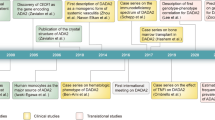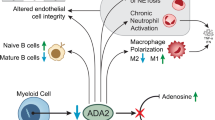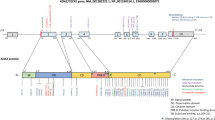Abstract
Purpose of Review
A new autoinflammatory disease, deficiency of adenosine deaminase 2 (DADA2), caused by mutations in the CECR1 gene, was first reported in 2014. This review aims to update progress in defining, treating, and understanding this multi-faceted disorder.
Recent Findings
DADA2 was first described in patients with systemic inflammation, mild immune deficiency, and vasculopathy manifested as recurrent stroke or polyarteritis nodosa (PAN). More than 125 patients have now been reported, and the phenotype has expanded to include children and adults presenting primarily with pure red cell aplasia (PRCA), or with antibody deficiency. Age of onset and clinical severity vary widely, even among related patients, and are not clearly related to CECR1 genotype. Inflammatory features often respond to anti-TNF agents, but marrow failure and severe immune deficiency may require hematopoietic stem cell transplantation.
Summary
ADA2 is expressed and secreted by monocytes and macrophages, but its biological function and the pathogenesis of DADA2 are uncertain and will remain an important area of research. Pre-clinical investigation of ADA2 replacement therapy and CECR1-directed gene therapy are warranted, but complicated by the absence of a suitable animal model.
Similar content being viewed by others
References
Papers of particular interest, published recently, have been highlighted as: • Of importance •• Of major importance
Manthiram K, Zhou Q, Aksentijevich I, Kastner DL. The monogenic autoinflammatory diseases define new pathways in human innate immunity and inflammation. Nat Immunol. 2017;18(8):832–42. https://doi.org/10.1038/ni.3777.
•• Zhou Q, Yang D, Ombrello AK, Zavialov AV, Toro C, Zavialov AV, et al. Early-onset stroke and vasculopathy associated with mutations in ADA2. N Engl J Med. 2014;370(10):911–20. https://doi.org/10.1056/NEJMoa1307361. The first report of DADA2 as a cause of early-onset stroke. Provides experimental evidence supporting causalityof ADA2 deficiency and evidence implicating M1 macrophage polarization in pathogenesis
•• Navon Elkan P, Pierce SB, Segel R, Walsh T, Barash J, Padeh S, et al. Mutant adenosine deaminase 2 in a polyarteritis nodosa vasculopathy. N Engl J Med. 2014;370(10):921–31. https://doi.org/10.1056/NEJMoa1307362. The first report of DADA2 as a cause of familial and sporadic PAN. Provides evidence of the efficacy of anti-TNF therapy in controlling autoinflammation
Schrader WP, Pollara B, Meuwissen HJ. Characterization of the residual adenosine deaminating activity in the spleen of a patient with combined immunodeficiency disease and adenosine deaminase deficiency. Proc Natl Acad Sci U S A. 1978;75(1):446–50.
Iwaki-Egawa S, Yamamoto T, Watanabe Y. Human plasma adenosine deaminase 2 is secreted by activated monocytes. Biol Chem. 2006;387(3):319–21. https://doi.org/10.1515/BC.2006.042.
Zavialov AV, Gracia E, Glaichenhaus N, Franco R, Zavialov AV, Lauvau G. Human adenosine deaminase 2 induces differentiation of monocytes into macrophages and stimulates proliferation of T helper cells and macrophages. J Leukoc Biol. 2010;88(2):279–90. https://doi.org/10.1189/jlb.1109764.
Zavialov AV, Engstrom A. Human ADA2 belongs to a new family of growth factors with adenosine deaminase activity. Biochem J. 2005;391(Pt 1):51–7. https://doi.org/10.1042/BJ20050683.
Zavialov AV, Yu X, Spillmann D, Lauvau G, Zavialov AV. Structural basis for the growth factor activity of human adenosine deaminase ADA2. J Biol Chem. 2010;285(16):12367–77. https://doi.org/10.1074/jbc.M109.083527.
Poursharifi P, Saghiri R, Ebrahimi-Rad M, Nazem H, Pourpak Z, Moin M, et al. Adenosine deaminase in patients with primary immunodeficiency syndromes: the analysis of serum ADA1 and ADA2 activities. Clin Biochem. 2009;42(13–14):1438–43. https://doi.org/10.1016/j.clinbiochem.2008.10.019.
Caorsi R, Penco F, Schena F, Gattorno M. Monogenic polyarteritis: the lesson of ADA2 deficiency. Pediatr Rheumatol Online J. 2016;14(1):51. https://doi.org/10.1186/s12969-016-0111-7.
Berkun Y, Segel R, Navon-Elkan P. Adenosine deaminase 2 deficiency: more than monogenic vasculitis. Isr Med Assoc J. 2017;19(7):435–7.
• Ozen S. The changing face of polyarteritis nodosa and necrotizing vasculitis. Nat Rev Rheumatol. 2017;13(6):381–6. https://doi.org/10.1038/nrrheum.2017.68. A thoughtful and informative recent review of PAN
Garg N, Kasapcopur O, Foster J 2nd, Barut K, Tekin A, Kizilkilic O, et al. Novel adenosine deaminase 2 mutations in a child with a fatal vasculopathy. Eur J Pediatr. 2014;173(6):827–30. https://doi.org/10.1007/s00431-014-2320-8.
• van Montfrans J, Zavialov A, Zhou Q. Mutant ADA2 in vasculopathies. N Engl J Med. 2014;371(5):478. https://doi.org/10.1056/NEJMc1405506#SA1. HSCT from a matched allogeneic donor was performed for PRCA in a patient later discovered to have DADA2. Serum ADA2 and clinical status were normal 11 years post transplant
• Van Eyck L Jr, Hershfield MS, Pombal D, Kelly SJ, Ganson NJ, Moens L, et al. Hematopoietic stem cell transplantation rescues the immunologic phenotype and prevents vasculopathy in patients with adenosine deaminase 2 deficiency. J Allergy Clin Immunol. 2015;135(1):283–7 e5. https://doi.org/10.1016/j.jaci.2014.10.010. Describes the complicated course and successful HSCT in one of two siblings with DADA2, and documents elevated IL-6 in both siblings
Van Eyck L, Liston A, Meyts I. Mutant ADA2 in vasculopathies. N Engl J Med. 2014;371(5):478–9. https://doi.org/10.1056/NEJMc1405506#SA2.
• Van Eyck L, Liston A, Wouters C. Mutant ADA2 in vasculopathies. N Engl J Med. 2014;371(5):480. https://doi.org/10.1056/NEJMc1405506#SA4. DADA2 as a cause of HHV8-negativer Castleman disease, effectively treated with anti-IL6
• Bras J, Guerreiro R, Santo GC. Mutant ADA2 in vasculopathies. N Engl J Med. 2014;371(5):478–80. https://doi.org/10.1056/NEJMc1405506#SA3. DADA2 as a cause of familial Sneddon syndrome (onset of livedo racemosa and stroke in the second decade of life)
•• Belot A, Wassmer E, Twilt M, Lega JC, Zeef LA, Oojageer A, et al. Mutations in CECR1 associated with a neutrophil signature in peripheral blood. Pediatr Rheumatol Online J. 2014;12:44. https://doi.org/10.1186/1546-0096-12-44. Disconvery of interfereon signature and overexpression of neutrophil genes in two patients with DADA2. Suggests inflammatory features and PAN may result from chronic neutophil activation
Gonzalez Santiago TM, Zavialov A, Saarela J, Seppanen M, Reed AM, Abraham RS, et al. Dermatologic features of ADA2 deficiency in cutaneous polyarteritis nodosa. JAMA Dermatol. 2015;151(11):1230–4. https://doi.org/10.1001/jamadermatol.2015.1635.
Abraham RS, Gibson LE. Error in complementary DNA nomenclature in “Dermatologic Features of ADA2 Deficiency in Cutaneous Polyarteritis Nodosa”. JAMA Dermatol. 2016;152(9):1065. https://doi.org/10.1001/jamadermatol.2016.2595.
Westendorp WF, Nederkoorn PJ, Aksentijevich I, Hak AE, Lichtenbelt KD, Braun KP. Unexplained early-onset lacunar stroke and inflammatory skin lesions: consider ADA2 deficiency. Neurology. 2015;84(20):2092–3. https://doi.org/10.1212/WNL.0000000000001581.
• Batu ED, Karadag O, Taskiran EZ, Kalyoncu U, Aksentijevich I, Alikasifoglu M, et al. A case series of adenosine deaminase 2-deficient patients emphasizing treatment and genotype-phenotype correlations. J Rheumatol. 2015;42(8):1532–4. https://doi.org/10.3899/jrheum.150024. Highlights weak correlation between genotype and phenotype
Fellmann F, Angelini F, Wassenberg J, Perreau M, Arenas Ramirez N, Simon G, et al. IL-17 receptor A and adenosine deaminase 2 deficiency in siblings with recurrent infections and chronic inflammation. J Allergy Clin Immunol. 2016;137(4):1189–96 e1-2. https://doi.org/10.1016/j.jaci.2015.07.053.
Keer N, Hershfield M, Caskey T, Unizony S. Novel compound heterozygous variants in CECR1 gene associated with childhood onset polyarteritis nodosa and deficiency of ADA2. Rheumatology (Oxford). 2016;55(6):1145–7. https://doi.org/10.1093/rheumatology/kew050.
• Nanthapisal S, Murphy C, Omoyinmi E, Hong Y, Standing A, Berg S, et al. Deficiency of adenosine deaminase type 2: a description of phenotype and genotype in fifteen cases. Arthritis Rheumatol. 2016;68(9):2314–22. https://doi.org/10.1002/art.39699. Highlights phenotypic heterogeneity in related patients homozygous for the same CECR1 mutation
Uettwiller F, Sarrabay G, Rodero MP, Rice GI, Lagrue E, Marot Y, et al. ADA2 deficiency: case report of a new phenotype and novel mutation in two sisters. RMD Open. 2016;2(1):e000236. https://doi.org/10.1136/rmdopen-2015-000236.
• Ben-Ami T, Revel-Vilk S, Brooks R, Shaag A, Hershfield MS, Kelly SJ, et al. Extending the clinical phenotype of adenosine deaminase 2 deficiency. J Pediatr. 2016;177:316–20. https://doi.org/10.1016/j.jpeds.2016.06.058. Highlights PRCA and other hematologic disorders in patients with DADA2 from several Arab families
• Van Montfrans JM, Hartman EA, Braun KP, Hennekam EA, Hak EA, Nederkoorn PJ, et al. Phenotypic variability in patients with ADA2 deficiency due to identical homozygous R169Q mutations. Rheumatology (Oxford). 2016;55(5):902–10. https://doi.org/10.1093/rheumatology/kev439. Highlights phenotypic heterogeneity in related patients homozygous for the same CECR1 mutation
Schepp J, Bulashevska A, Mannhardt-Laakmann W, Cao H, Yang F, Seidl M, et al. Deficiency of adenosine deaminase 2 causes antibody deficiency. J Clin Immunol. 2016;36(3):179–86. https://doi.org/10.1007/s10875-016-0245-x.
• Hsu AP, West RR, Calvo KR, Cuellar-Rodriguez J, Parta M, Kelly SJ, et al. Adenosine deaminase type 2 deficiency masquerading as GATA2 deficiency: successful hematopoietic stem cell transplantation. J Allergy Clin Immunol. 2016;138(2):628–30 e2. https://doi.org/10.1016/j.jaci.2016.03.016. DADA2 as a cause of MonoMAC syndrome, successfully treated by HSCT
Poswar Fde O, da Fonseca RM, de Albuquerque LC, Zhou Q, Jardim LB, Monte TL, et al. Adenosine deaminase 2 deficiency presenting as spastic paraplegia and systemic vasculitis. J Neurol. 2016;263(4):818–20. https://doi.org/10.1007/s00415-016-8070-y.
Elbracht M, Mull M, Wagner N, Kuhl C, Abicht A, Kurth I, et al. Stroke as initial manifestation of adenosine deaminase 2 deficiency. Neuropediatrics. 2017;48(2):111–4. https://doi.org/10.1055/s-0036-1597611.
• Hashem H, Egler R, Dalal J. Refractory pure red cell aplasia manifesting as deficiency of adenosine deaminase 2. J Pediatr Hematol Oncol. 2017; https://doi.org/10.1097/MPH.0000000000000805. Successful HSCT for PRCA following diagnosis of DADA2
• Hashem H, Vatsayan A, Gupta A, Nagle K, Hershfield M, Dalal J. Successful reduced intensity hematopoietic cell transplant in a patient with deficiency of adenosine deaminase 2. Bone Marrow Transplant. 2017; https://doi.org/10.1038/bmt.2017.173.
Caorsi R, Penco F, Grossi A, Insalaco A, Omenetti A, Alessio M, et al. ADA2 deficiency (DADA2) as an unrecognised cause of early onset polyarteritis nodosa and stroke: a multicentre national study. Ann Rheum Dis. 2017; https://doi.org/10.1136/annrheumdis-2016-210802.
•• Schepp J, Proietti M, Frede N, Buchta M, Hubscher K, Rojas Restrepo J, et al. Screening of 181 patients with antibody deficiency for deficiency of adenosine deaminase 2 sheds new light on the disease in adulthood. Arthritis Rheumatol. 2017;69(8):1689–700. https://doi.org/10.1002/art.40147. Screening idenitfied DADA2 in 11 (6%) of 181 patients with antibody deficiency (CVID)
Skrabl-Baumgartner A, Plecko B, Konig N, Hershfield M, Gruber-Sedlmayr U, Lee-Kirsch MA. Autoimmune phenotype with type I interferon signature in two brothers with ADA2 deficiency carrying a novel CECR1 mutation. Pediatr Rheumatol. 2017;15(1):67. https://doi.org/10.1186/s12969-017-0193-x.
Ombrello A, Stone D, Hoffmann P, Jones A, Barham B, Barron K et al. The deficiency of adenosine deaminase type 2—results of therapeutic intervention. Pediatric Rheumatology. 2015;13 (Suppl 1). doi:https://doi.org/10.1186/1546-0096-13-S1-O40.
•• Hashem H, R A, Kumar AR, Müller I, Babor F, Bredius R et al. Hematopoietic stem cell transplantation rescues the hematological, immunological and vascular phenotype in DADA2. Blood. 2017, in Press. Reviews the experience with HSCT performed in 14 patients with DADA2.
Azzari C, la Marca G, Resti M. Neonatal screening for severe combined immunodeficiency caused by an adenosine deaminase defect: a reliable and inexpensive method using tandem mass spectrometry. J Allergy Clin Immunol. 2011;127(6):1394–9. https://doi.org/10.1016/j.jaci.2011.03.040.
Richard E, Arredondo-Vega FX, Santisteban I, Kelly SJ, Patel DD, Hershfield MS. The binding site of human adenosine deaminase for CD26/dipeptidyl peptidase IV: the Arg142Gln mutation impairs binding to cd26 but does not cause immune deficiency. J Exp Med. 2000;192(9):1223–36.
Homma K, Matsushita T, Natori S. Purification, characterization, and cDNA cloning of a novel growth factor from the conditioned medium of NIH-Sape-4, an embryonic cell line of Sarcophaga peregrina (flesh fly). J Biol Chem. 1996;271(23):13770–5.
Homma KJ, Tanaka Y, Matsushita T, Yokoyama K, Matsui H, Natori S. Adenosine deaminase activity of insect-derived growth factor is essential for its growth factor activity. J Biol Chem. 2001;276(47):43761–6. https://doi.org/10.1074/jbc.M105088200.
Zurovec M, Dolezal T, Gazi M, Pavlova E, Bryant PJ. Adenosine deaminase-related growth factors stimulate cell proliferation in Drosophila by depleting extracellular adenosine. Proc Natl Acad Sci U S A. 2002;99(7):4403–8. https://doi.org/10.1073/pnas.062059699.
Riazi MA, Brinkman-Mills P, Nguyen T, Pan H, Phan S, Ying F, et al. The human homolog of insect-derived growth factor, CECR1, is a candidate gene for features of cat eye syndrome. Genomics. 2000;64(3):277–85. https://doi.org/10.1006/geno.1999.6099.
Charlab R, Valenzuela JG, Andersen J, Ribeiro JM. The invertebrate growth factor/CECR1 subfamily of adenosine deaminase proteins. Gene. 2001;267(1):13–22.
Kaljas Y, Liu C, Skaldin M, Wu C, Zhou Q, Lu Y, et al. Human adenosine deaminases ADA1 and ADA2 bind to different subsets of immune cells. Cell Mol Life Sci. 2017;74(3):555–70. https://doi.org/10.1007/s00018-016-2357-0.
Author information
Authors and Affiliations
Corresponding author
Ethics declarations
Conflict of Interest
Michael S Hershfield receives grant support from Leadiant Biosciences, Inc., the manufacturer of Adagen, a PEGylated adenosine deaminase used to treat patients with ADA1 deficiency.
Hasan Hashem, Susan J Kelly, and Nancy J Ganson declare they have no conflicts of interest.
Human and Animal Rights and Informed Consent
This article does not contain any studies with human or animal subjects performed by any of the authors.
Additional information
This article is part of the Topical Collection on Orphan Diseases
Rights and permissions
About this article
Cite this article
Hashem, H., Kelly, S.J., Ganson, N.J. et al. Deficiency of Adenosine Deaminase 2 (DADA2), an Inherited Cause of Polyarteritis Nodosa and a Mimic of Other Systemic Rheumatologic Disorders. Curr Rheumatol Rep 19, 70 (2017). https://doi.org/10.1007/s11926-017-0699-8
Published:
DOI: https://doi.org/10.1007/s11926-017-0699-8




